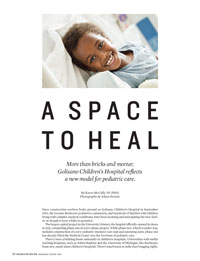Features
Photographs by Adam Fenster
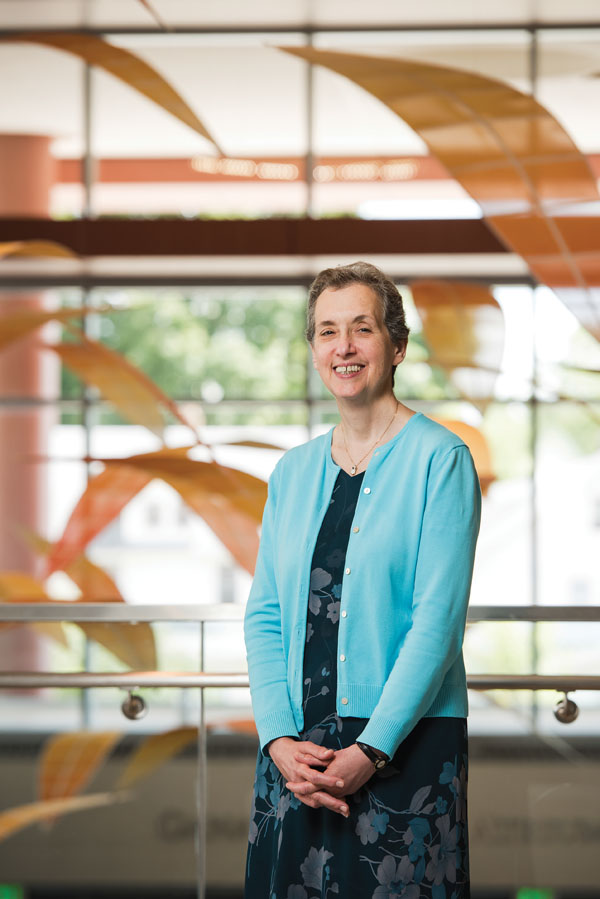 PEDIATRICIAN-IN-CHIEF: Nina Schor, the William H. Eilinger Chair of Pediatrics, presides over the eight-story, stand-alone Golisano Children’s Hospital. Teagan Wagner, 8, of Honeoye Falls, New York, admitted for hip surgery in July, was among the first patients in the new hospital (opposite). (Photo: Adam Fenster)
PEDIATRICIAN-IN-CHIEF: Nina Schor, the William H. Eilinger Chair of Pediatrics, presides over the eight-story, stand-alone Golisano Children’s Hospital. Teagan Wagner, 8, of Honeoye Falls, New York, admitted for hip surgery in July, was among the first patients in the new hospital (opposite). (Photo: Adam Fenster)Since construction workers broke ground on Golisano Children’s Hospital in September 2012, the Greater Rochester pediatrics community, and hundreds of families with children living with complex medical conditions, have been awaiting and anticipating the new facility as though it were a baby in gestation.
Features
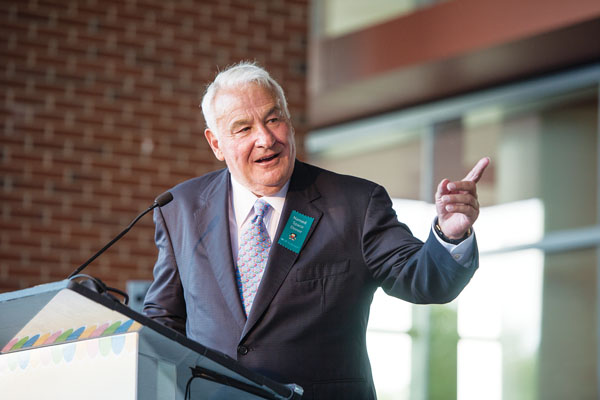 NAMESAKE: “The only wealth that you get to keep is that which you give away,” said Golisano, the hospital’s lead benefactor, at a dedication ceremony in May. (Photo: Adam Fenster)
NAMESAKE: “The only wealth that you get to keep is that which you give away,” said Golisano, the hospital’s lead benefactor, at a dedication ceremony in May. (Photo: Adam Fenster)It was B. Thomas Golisano’s $20 million lead gift in 2011 that set plans in motion to build the new hospital. A longtime generous donor to the University, Golisano had already given $14 million in 2002 to what was then the Strong Children’s Hospital for upgrades to laboratories, medical technology, and the recruitment of a significant number of additional clinical experts and faculty members. But as Golisano observed in his 2011 announcement, “A new facility is necessary to keep pace with medical and technological advancements and meet the modern standards of a children’s hospital.”
A native of Irondequoit, just outside Rochester, Golisano is the founder of Paychex, which is among the nation’s leading payroll processing firms. Since 1985, he has given nearly $150 million to various institutions, with a focus on health care, education, and services and opportunities for people with intellectual disabilities. In addition to his two gifts to the hospital totaling $34 million, Golisano’s foundation has given more than $2 million to establish a partnership with the University, the Institute for Innovative Transition, serving young adults with developmental disabilities as they make their way to further education or the workforce, and to support initiatives to improve oral health care for individuals with intellectual and developmental disabilities.
The largest capital project in the University’s history, the hospital officially opened its doors in July, completing phase one of a two-phase project. While phase two, which is under way, includes construction of a new pediatric intensive care unit and operating suite, phase one has already lifted the Medical Center into the forefront of pediatric care.
There’s been a building boom nationally in children’s hospitals. Universities with stellar teaching hospitals, such as Johns Hopkins and the University of Michigan, like Rochester, boast new, stand-alone children’s hospitals. There’s much more at stake than bragging rights. Nina Schor, the William H. Eilinger Chair of Pediatrics and pediatrician-in-chief of the hospital, says the trend is taking place because “in some ways, we are victims of our own success.”
“Children who not that many years ago would have succumbed to chronic illness long before they reached adulthood are not only surviving, but in many cases thriving,” she says. “But they need episodic help when they have an exacerbation of their illness, or they may need technology to keep them healthy and functioning.”
It’s also the case that the entire approach to caring for children in the hospital has changed.
A generation ago, it was standard procedure to keep parents out of the room when doctors or nurses drew blood from a child, started an IV, or performed a spinal tap, for example. In recent years, the thinking has changed dramatically. Parents are welcomed as part of the health care team as never before. They’re not only a source of comfort to their child, but they hold important information that medical professionals might not be able to elicit from the child on their own. And when the child is released, it’s helpful for parents to know as much as possible about the treatments their child has endured, and how to care for the patient at home.
“The whole mind-set has changed 180 degrees,” says Schor. “But this requires a very different physical plant.”
The centerpiece of the Medical Center’s component of The Meliora Challenge: The Campaign for the University of Rochester, the eight-story, 245,000-square-foot hospital is named for Paychex founder and philanthropist B. Thomas Golisano, who provided the lead gift of $20 million. The new hospital includes 52 private patient rooms, spacious enough for parents to stay comfortably with their child. It also houses conference rooms that provide a quiet setting for parents to meet with their child’s health care team. Computer terminals, as well as a professional liaison librarian, are available to help family members who often want to learn as much as they can about their child’s illness. The hospital also includes meeting places large enough for families to interact. “You need a space big enough for families to meet with one another so that the families more experienced with a particular illness can talk to the families with a child who’s newly diagnosed,” says Schor.
The new building allows for major improvements in the care of premature or sick infants, who make up a sizeable portion of the patient population. As in the rest of the hospital, parents can stay with their child in the 68-bed Gosnell Family Neonatal Intensive Care Unit.
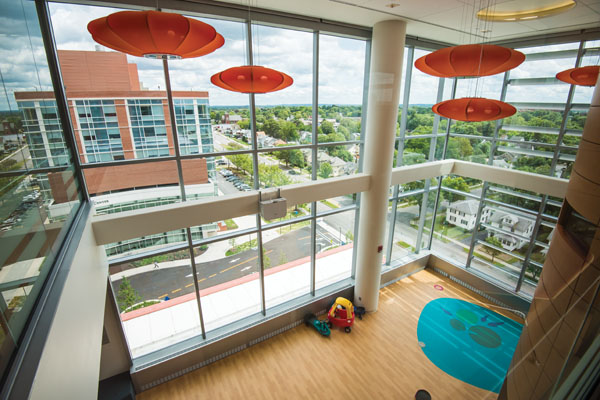 A PLAYFUL DESIGN: The seventhfloor Christie Simonetti Playdeck offers a space to accommodate siblings and patients, and a scenic view, connecting patients to the world outside the hospital walls. (Photo: Adam Fenster)
A PLAYFUL DESIGN: The seventhfloor Christie Simonetti Playdeck offers a space to accommodate siblings and patients, and a scenic view, connecting patients to the world outside the hospital walls. (Photo: Adam Fenster)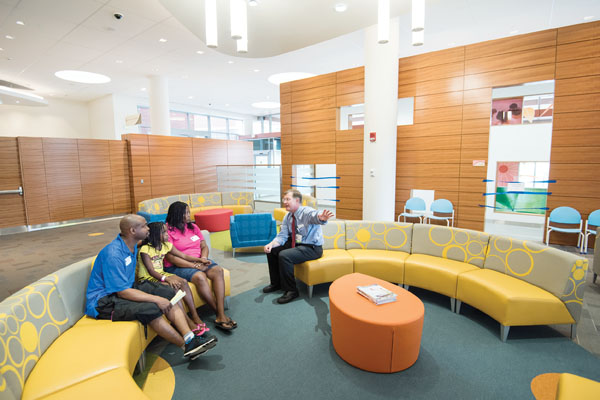 FAMILY-CENTERED: Chief clinical officer Tim Stevens consults with members of the Williams family—parents Terrence and Michelle and daughter Rusheen—about son Roshane, 15, a dialysis patient, in the Walmart and Sam’s Club Pediatric Lobby; the Ganatra Family Atrium (middle) and Grace’s Garden (bottom), named in honor of Grace Esposito, contribute to a welcoming environment, as does a second garden, Laura’s Garden, named in honor of Laura Olander. (Photo: Adam Fenster)
FAMILY-CENTERED: Chief clinical officer Tim Stevens consults with members of the Williams family—parents Terrence and Michelle and daughter Rusheen—about son Roshane, 15, a dialysis patient, in the Walmart and Sam’s Club Pediatric Lobby; the Ganatra Family Atrium (middle) and Grace’s Garden (bottom), named in honor of Grace Esposito, contribute to a welcoming environment, as does a second garden, Laura’s Garden, named in honor of Laura Olander. (Photo: Adam Fenster)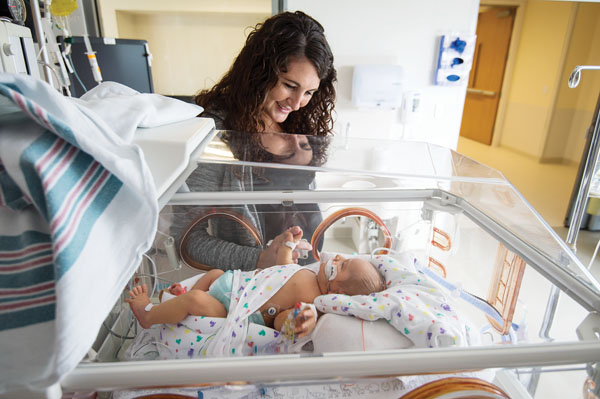 HEALING TOUCH: Danielle Scarborough, of Elba, New York, holds the hand of her son, Hudson, born by emergency C-section in July (top); the eighthfloor elevator lobby introduces the geographic theme of that floor (middle); the Bradford C. Berk Imaging Lobby (bottom) brings light and space to the hospital’s ground floor. (Photo: Adam Fenster)
HEALING TOUCH: Danielle Scarborough, of Elba, New York, holds the hand of her son, Hudson, born by emergency C-section in July (top); the eighthfloor elevator lobby introduces the geographic theme of that floor (middle); the Bradford C. Berk Imaging Lobby (bottom) brings light and space to the hospital’s ground floor. (Photo: Adam Fenster)“Parents are soothing to the children,” says Tim Stevens ’87M (MD), ’05 (MPH), medical director of the NICU and clinical director of the hospital. “They promote the healing environment. And premature babies, sick babies, as they get older, start working on their feeding skills. To have mom near them for breastfeeding is obviously critical.”
There are smaller details as well, that nonetheless have a sizeable impact: healing gardens, play areas designed for both patients and their siblings, and bright murals featuring landscapes and cityscapes of western New York.
Schor emphasizes that the project is not yet finished. In a second phase, expected to be complete by 2017, the hospital will develop a pediatric heart transplant program, building on the skills and reputation of George Alfieris, an internationally recognized pediatric cardiologist and the only pediatric cardiac surgeon in the region.
The hospital will also construct a new pediatric intensive care unit and six pediatric operating rooms, capitalizing on the talents of Walter Pegoli, whom colleagues credit with building a first-rate surgical program in his role as chief of pediatric surgery and the Joseph M. Lobozzo II Professor in Pediatric Surgery.
Hospitals are, by their very nature, intense, emotional places. An important part of helping families make their way through the experience belongs to the Wegmans Child Life Program, whose specialists work with families to help bring some normalcy to their time in the hospital. But creating a hospital that offers peace, respite, and as much levity and play as patients can take on, is no easy task. On move-in day, for example, patients weren’t just rolled from the old facility into the new. They were treated to a scavenger hunt along the way.
“We prepared for any medical emergencies along the route and made sure that necessary equipment and monitoring were in place,” says Denise Clough, pediatric nurse manager. “The logistics and responsibility of transferring our patients was pretty intense, but we knew it was also important to have some fun along the way. After all, this is a pediatric hospital and we are all about the kids.”

